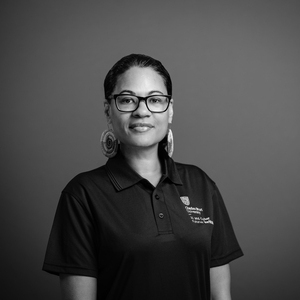The influence of emerging technologies in Australia has empowered First Nations and Indigenous Australians to redefine beauty on their own terms. It’s also offered a space for them to interrogate beauty as we’ve traditionally perceived it, asking the question, does it still serve us?

By Sasha Kutabah Sarago, First Nations Cultural Innovation and Technology Program Lead at the Artificial Intelligence and Cyber Futures Institute, Charles Sturt University
I know as a First Nations person, in the past, my relationship with beauty has been problematic. Because I was viewing it through a Western lens, which didn’t always reflect my authentic beauty back to me.
But when I shifted the beauty paradigm and started to look at beauty through a First Nations perspective, it allowed me to ask, how does beauty make me feel? Does it reflect the values of my culture and community?
With Western beauty standards, we run into the problem of it disempowering us. Often we are spoon-fed how to see ourselves and others. We can learn a lot by applying de-colonial thinking to the way that we perceive beauty. I think it will help empower us as a collective. As First Nations peoples, we need to be clear culturally about what is sacred. What we will and will not share. Making sure that cultural law is the guiding principle on how we use and interact with new technologies, like First Nations AI.
The mindful use of emerging technologies
We’re at an exciting point in time. Our Indigenous youth can drive the development of new emerging technologies, making sure that our Elders and communities are at the forefront of its development. This is a powerful example of Indigenous-led innovation, where community knowledge informs how new tools are built and used.
But new technology can also be a tool to protect and preserve legacy. For us that’s the legacy of the oldest continuous living culture in the world. But we have to be mindful that we employ data sovereignty protocols so that our data is controlled and owned by us as a community. Many times in the past, unfortunately, we’ve seen the theft and commodification and appropriation of Indigenous intellectual property and cultural knowledge. That is why First Nations leadership and engagement is important when we develop emerging technologies. It’s also why technology for Indigenous communities must be guided by our community values.
Technology plays a pivotal role in the preservation and promotion of First Nations beauty standards. When I launched Ascension, Australia’s first digital platform for women of colour, I celebrated a diversity of beauty standards. For instance, the ancient and matriarchal tradition of facial tattoos that belongs to the Melanesian and Polynesian communities. We talked about the natural hair movement and the cultural significance of hair braiding. This fed into a global dialogue about the development of anti-racism and discrimination policies.
For instance, in the US, they have the Crown Act. This protects the natural protective styles of women of colour and to gain back their human rights and equal opportunities in a variety of industries.
Emerging technologies can be a form of advocacy
Digital technology has helped First Nations people challenge the way that others perceive our beauty. As a First Nations woman, I know in the past it hasn’t always been seen in the best light. Take for instance the very sexist and racist statement, “You’re too pretty to be Aboriginal.” Unfortunately I’ve been on the receiving end of this. But I’ve used the medium of documentary to challenge that offensive statement. Now our Indigenous youth have social media, such as TikTok and Instagram, to call out racism, but also educate the masses whilst doing so.
The digital world has also brought together Indigenous creators, such as Black Lens, a cohort of videographers, photographers and digital storytellers. For the first time, you’re seeing traditional and contemporary forms of beauty and femininity being captured by First Nations women. The digital world is a wonderful place for First Nations to play and explore their traditions and identity. So I believe that digital technology is a form of advocacy for First Nations communities. This kind of innovation also supports digital inclusion, ensuring First Nations voices and stories are seen and heard in global conversations.
Digital storytelling has enabled First Nations women to discuss beauty and femininity in a unique way. One that is distinct to our culture. For me, I’ve used my book Gigorou to discuss beauty and femininity through creation and matriarchal stories. But what if I applied new technology, like augmented reality? I believe it would enhance the storytelling, but also provide the audience an immersive experience.
Bridging the gap
As a First Nations person, I’m often asked the question, “How do you define connection to Country?” If I use technology, say, augmented reality, that allows the person to step into my shoes. So we can co-create and share a new reality.
First Nations people are underrepresented in the beauty industry and have been for many years. I see emerging technologies as bridging that gap. Providing us unlimited access to the industry. But also in the global market, Indigenous beauty influencers, brands and entrepreneurs are able to use technologies like virtual try-ons or user generated content.
The data and insights from emerging technologies can help companies better understand and create inclusive and diverse policies or representation when it comes to beauty products and services. Companies can use that data and insight to invite diverse communities to celebrate new beauty narratives.
In this way, these tools can also help improve outcomes for Indigenous Australians. Ensuring representation, cultural understanding, and authentic storytelling are embedded in future digital and beauty industries.
Use emerging technologies for good
Do you want to harness the power of tech to drive change and create a better future? You can, with Charles Sturt.
Start with an Undergraduate Certificate in Information Technology, then move on to the Bachelor of Information Technology1. You’ll learn the skills to design technology that empowers people and strengthens communities.
We also offer dedicated support for First Nations students, a First Nations Direct Entry Program, and scholarships specifically for First Nations students, to help you succeed every step of the way.
- CRICOS 012006F ↩︎



You must be logged in to post a comment.